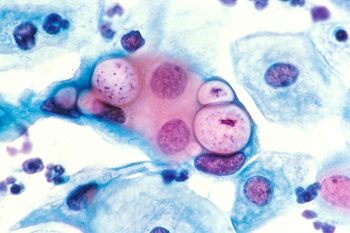Chlamydia is one of the most widespread STDs in the world. While it doesn’t always display symptoms, its affects may be severe and irreversible. This disease isn’t known as the silent infection for nothing. It’s considered to be the most prolific STD due to their cunning nature.
Chlamydia is known to utilize the “Trojan horse” tactics to stealthily sneak into host cells. With the help of the Pgp3 protein, it can often evade defenses and avoid detection, making it one of the most prevalent STDs worldwide with over 50 million cases worldwide and approximately 3 million cases in the United States annually.
What is Chlamydia?
 Chlamydia is a very common sexually transmitted disease (STD) caused by the bacterium chlamydia trachomatis. The term ‘chlamydia infection’ can also refer to infection caused by any species belonging to the bacterial family Chlamydiaceae.
Chlamydia is a very common sexually transmitted disease (STD) caused by the bacterium chlamydia trachomatis. The term ‘chlamydia infection’ can also refer to infection caused by any species belonging to the bacterial family Chlamydiaceae.
Chlamydia is a major infectious cause of human genital and eye disease. It’s one of the most common sexually transmitted infections worldwide; it is estimated that about 1 million individuals in the United States are infected with chlamydia.
In 2011, approximately 1.4 million cases of chlamydia were reported to CDC from 50 states and the District of Columbia, but an estimated 2.86 million infections occur annually.
A large number of cases are not reported because most people with chlamydia are asymptomatic and do not seek testing.
Chlamydia is most common among young people. Its prevalence among sexually-active young people aged 14-24 years is nearly three times the prevalence among people aged 25-39 years. It is estimated that 1 in 15 sexually active females aged 14-19 years has chlamydia.
How it spreads
Chlamydia is transmitted through sexual contact with the penis, vagina, mouth, or anus of an infected partner. Ejaculation does not have to occur for chlamydia to be transmitted or acquired.
Chlamydia can also be spread perinatally from an untreated mother to her baby during childbirth, resulting in ophthalmia neonatorum or pneumonia in some exposed infants.
People who have had chlamydia and have been treated may get infected again if they have sexual contact with a person infected with chlamydia.
Chlamydia symptoms
Chlamydia isn’t known as the ‘silent infection’ for nothing. Most people who have contracted this disease don’t notice any symptoms, and so don’t know they have it. Research suggests that 50% of men and 70 – 80% of women don’t get symptoms at all with chlamydia infection.
For those who do experience symptoms, they may include: pain when you urinate, unusual discharge from the penis, vagina or rectum or, in women, bleeding between periods or after sex.
For the most part however, chlamydia is asymptomatic. If you’re unfortunate enough to have contracted chlamydia, there’s a good chance you won’t know about it until you start experiencing the complications.
Complications
The initial damage that chlamydia causes often goes unnoticed. However, chlamydial infections can lead to serious health problems with both short and long term consequences.
Reactive arthritis can occur in men and women following symptomatic or asymptomatic chlamydial infection, sometimes as part of a triad of symptoms along with urethritis and conjunctivitis, formerly referred to as Reiter’s Syndrome.
One of the more serious complications of chlamydia, however, is the fact that this infection may render many couples incapable of having children.
Chlamydia derives its power from its ability to hide in the human body. It has denied many women the joys of motherhood because it usually rears its hideous head after it has inflicted irreversible damage to the critical reproductive organs.
It is therefore imperative that sexually active men and women be tested for chlamydia at least once a year.
Chlamydia can be cured completely
Chlamydia is a relatively easy infection to treat. However, it may be one of the most difficult to detect due to the elusive nature of the disease as well as the misconceptions surrounding it. And that’s basically the aim of this article; to share knowledge and to dispel the confusion caused by misconceptions.
In cases where chlamydia is detected, the treatment is with antibiotics.
Homeopathic Treatment
Apart from the conventional allopathic treatments – homeopathic, herbal and other natural medicines are also available and have been found to be quite effective. (more.. Chlamydia facts)








 Saving...
Saving...
Pingback: Chlamydia in Men - STDZip
Pingback: Chlamydia in Women - STDZip
Pingback: Is Chlamydia Curable? Here are The Facts! - STDZip.com